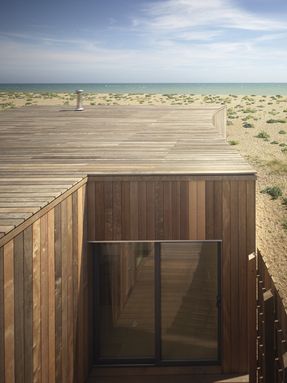ARCHITECTS
Simon Conder Associates
PHOTOGRAPHS
Courtesy of Simon Conder Associates
PROJECT YEAR
2008
LOCATION
Kent, United Kingdom
CATEGORY
Houses
Text description provided by architect.
Dungeness beach is a classic example of ‘Non-Plan’ and the houses that populate the beach have developed through improvisation and bodge.
This scheme develops this tradition in a way that responds to the drama and harshness of the landscape.
El Ray is part of a group of five beach houses located immediately to the east of the huge Dungeness A power station. The original house consisted of a 19th century railway carriage with flimsy lean tos to the north and south.
It was in extremely poor condition and too small to accommodate our clients and their growing family. We were asked by our clients to increase the accommodation area by approximately 50%, and dramatically improve the environmental performance of the house.
The new house incorporates the old railway carriage inside a highly insulated timber structure. The carriage forms the centre point of the main living area and accommodates the kitchen.
A fully glazed southern elevation gives views out over the channel and a series of smaller slot windows on the other elevations give focused views of the adjacent lighthouse, coastguard station and nuclear power station.
The sloping roof deck acts as an observation platform with extraordinary 360 degree views of the beach and the sea. The plan incorporates two courtyards to provide shelter from the constant wind.
ENVIRONMENTAL PERFORMANCE
Environmental control is achieved through a combination of super insulation, passive solar gain, cross ventilation and a wind turbine.
The high levels of insulation in the walls, roof and floor ensure that heat loss from the building is minimal and very little energy is required for heating, lighting and ventilation.
External glazing consists of a combination of double-glazed, low ‘E’, argon- filled frameless fixed lights and thermally-broken, aluminium sliding doors. The structural timber frame is constructed from lightweight engineered timber I-Joists, braced inside and out with a sheathing material manufactured entirely from wood waste.
The insulation between the I-joists and studs is made from recycled newspaper. The external cladding and decking is made from an FSC certified hardwood called Itauba and the internal wall linings, floors and all joinery are constructed from FSC certified birch plywood.
A canopy projects out over the south deck to shade the living areas from the high summer sun, but allows the low winter sun to warm the house. When necessary a wood-burning stove, using drift wood from the beach, is used to supplement the passive solar gain in the winter months and in extremely cold conditions electric under floor heating, powered by the wind turbine, will heat the two bedrooms and the bathroom.















